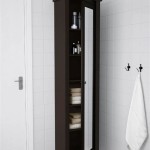How to Hang a Mirror Without Holes
Hanging a mirror without creating holes in the wall offers a damage-free solution, particularly beneficial for renters or those who frequently redecorate. This approach preserves wall integrity and provides flexibility for repositioning mirrors as desired. Several effective methods cater to various mirror sizes and wall types.
1. Adhesive Strips
Adhesive strips designed specifically for hanging mirrors offer a convenient and straightforward solution for lighter mirrors. These strips utilize a strong adhesive that bonds securely to various surfaces, including painted walls, tiles, and wood. Ensure the wall surface is clean and dry before application. Carefully follow the manufacturer’s instructions regarding weight limits and application techniques. Generally, the strips are applied to the back of the mirror and then pressed firmly against the wall. The adhesive requires a certain period to set fully, so avoid placing any objects against the mirror until then. It's crucial to choose strips appropriate for the mirror's weight to prevent accidental detachment.
2. Mirror Mounting Tape
Similar to adhesive strips, mirror mounting tape provides an alternative for securing mirrors without drilling. Mounting tape is generally stronger than adhesive strips and can accommodate slightly heavier mirrors. This method works best on smooth, non-porous surfaces. Thoroughly clean the wall area where the mirror will hang to ensure optimal adhesion. Apply the tape to the back of the mirror, following the manufacturer's instructions for spacing and placement. Carefully align the mirror on the wall and apply consistent pressure to ensure a secure bond. Allow sufficient time for the adhesive to cure before disturbing the mirror.
3. Leaning Mirrors
For larger, heavier mirrors, leaning against a wall offers a simple, hole-free alternative to traditional hanging methods. This approach creates a casual, stylish aesthetic and suits various room designs. Position the mirror securely against a stable wall, ensuring proper weight distribution to prevent tipping. For added stability, consider using non-slip pads or small furniture anchors between the mirror and the wall and the floor to minimize movement. This method is particularly suitable for full-length mirrors or decorative mirrors used as statement pieces.
4. Temporary Hooks
Certain types of temporary hooks, designed for damage-free hanging, can support lightweight mirrors. These hooks typically employ adhesive backs or suction cups that adhere to the wall without leaving residue. Ensure the wall surface is clean and dry before applying the hooks. Follow the manufacturer’s guidelines for weight limitations. Once the hooks are securely attached, carefully hang the mirror. This method offers a removable and adjustable hanging solution.
5. Mirror Clips
Mirror clips, typically designed for frameless mirrors, offer a more secure method for hanging without drilling. These clips clamp onto the edges of the mirror and are affixed to the wall using adhesive or temporary hooks. This approach ensures the mirror remains firmly in place while distributing the weight evenly. Mirror clips are often used in bathrooms and other areas where a secure hold is essential. Choose clips that are compatible with the mirror's thickness and weight.
6. Wall-Mounted Shelves or Ledger Boards
Utilizing existing wall-mounted shelves or installing a small, decorative ledger board provides a platform to support a mirror without directly attaching it to the wall. This method is particularly suitable for smaller mirrors or for creating a curated display alongside other decorative items. Ensure the shelf or ledger board is securely attached to the wall, considering the combined weight of the mirror and any other objects placed on it. Lean the mirror against the wall, supported by the shelf or ledger board, ensuring a stable and visually appealing arrangement.
7. Decorative Rope or Straps
For a more unique and decorative approach, consider using rope or straps to hang a mirror. Securely attach the rope or straps to the back of the mirror frame using strong adhesive or by tying knots around existing hardware. Then, hang the rope or straps over decorative hooks or nails that are already in the wall, or use temporary hooks. This method adds a touch of rustic or bohemian charm to a space. Ensure the rope or straps are strong enough to support the weight of the mirror and are securely fastened to prevent slippage. Adjust the length of the rope or straps to achieve the desired hanging height.

3 Simple Ways To Hang A Mirror On Wall Without Nails Wikihow

3 Simple Ways To Hang A Mirror On Wall Without Nails Wikihow

3 Simple Ways To Hang A Mirror On Wall Without Nails Wikihow

3 Simple Ways To Hang A Mirror On Wall Without Nails Wikihow

Damiano Shelton On Linkedin How To Hang A Heavy Mirror Without Nails Worst Room

How To Hang A Heavy Mirror At Home

How To Hang A Mirror On Wall Without Nails

3 Simple Ways To Hang A Mirror On Wall Without Nails Wikihow
How To Hang A 100 Pound Mirror On Drywall Quora

How To Hang A Mirror On The Wall Without Nails Tiktok Search








